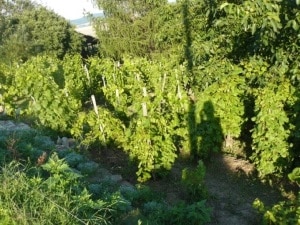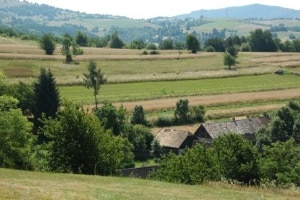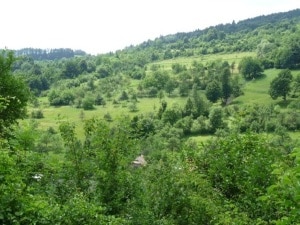
 Traditional vineyard agricultural landscapes
Traditional vineyard agricultural landscapes
Traditional agricultural landscapes (TAL) in Slovakia are unique remnants of small-scale agriculture, with cultural, biological, and aesthetic significance. Typical small-scale mosaics often copy specific forms of anthropogenic relief (terraces, balks, stone walls) and form a beautiful landscape pattern.
The presence of unique folk architectonic features such as vineyard houses, cellars, and religious features often increases the beauty and cultural-historical value of these landscapes. After complicated political and economic changes during the 20th century, they survive on only 0.9% of the area of Slovakia, mostly in mountains, and are extensively abandoned.
The changing political landscapeThe plains, basin valleys, and hilly parts of the landscape have all been cultivated in Slovakia over the centuries. The unique, small-scale division of land parcels stemmed from the adaptation of Hungarian Tripartitum law in 1514, which secured equal land division between each of a farmer’s descendants. The farmers used to mark the boundaries using hedgerows, or with stones that they picked up during land cultivation. This formed the narrow stripped fields with unique forms of anthropogenic relief, such as terraces, stony walls, balks, etc.
 Traditional dispersed settlement agricultural landscapes
Traditional dispersed settlement agricultural landscapes
The collectivization of agriculture, which occurred from 1950-1970, triggered huge changes in the agricultural landscape. Farmers were forced to hand over their land to collective farms – agricultural cooperatives where the emphasis was on maximizing production of agricultural commodities. Small-scale fields, managed by individual owners or families, were merged into large fields managed by agricultural corporations. Stone walls were removed, and hedgerows and terraces were ploughed up. It was only in less accessible, less fertile localities that the original agricultural landscape was partially preserved, and did not lose the shape of a cultural-historical countryside.
The change in political system in 1989 and transition to an open-market economy increased imports of agricultural products, and a lack of subsidies caused a general decline in agriculture. This period saw the widespread abandonment of land, which affected both large-scale fields and TAL. Entry into the European Union and the implementation of the Common Agricultural Policy (CAP) in 2004 have had an ambivalent influence on the agricultural landscape. On the one hand, they brought renewed financial support for the agricultural sector; on the other hand, the CAP imposed several restrictions on farming (reduced quotas, cutbacks in production, and higher quality and hygiene standards).
 Traditional arable land and grassland agricultural landscapes
Traditional arable land and grassland agricultural landscapes
Application of the CAP also brought administrative and financial requirements that were particularly demanding for small farmers. Small-scale farming became unprofitable, and management of TALs decreased. Only half of TAL sites (50 percent) in Slovakia are still regularly managed, 34 percent are partly abandoned, and 16 percent are almost fully abandoned.
A need for agricultural managementExpansion of holiday homes is also significant, especially in vineyards. Residential house building, meanwhile, occurs near big cities as a consequence of urban sprawl. Agricultural fields are managed mostly by older farmers – the young generation is not very interested in traditional agricultural management. These farmers do not have the financial and technical resources to compete with producers applying intensive farming. Therefore, the inputs are higher than outputs and this results in an unsustainable situation.
The existence of TAL depends on human activity and specifically on agricultural management. The main goals of the strategy for TAL preservation should be:
- Support for sustainable development and enhancement of human resources in the sphere of management and protection
- Enhancement of public awareness of TAL values
- Elimination of threats to TAL through support for appropriate socio-economic conditions regarding the management of TAL
- Support tourism and regional development with respect to TAL values
- Support the research and monitoring of TAL
 Traditional arable land, grassland, and orchard agricultural landscapes
Traditional arable land, grassland, and orchard agricultural landscapes
An interest in maintaining the integrity of traditional landscapes is also present in the European Landscape Convention (CETS No. 176, 2000), as there are real threats of losing traditional landscapes and their genius loci. The recent CAP approach does not sufficiently reflect the specific local physical conditions of Slovak TALs. For example, small remote meadows and narrow fields with terraces and stone walls are not included in the support system (insufficient size, difficult access). The system is financially demanding and inaccessible for many rural farmers. Administrative tasks are a huge barrier, especially for older people. This challenge of maintaining traditional agricultural landscapes is addressed to individuals as well as to the politicians who decide development policy.
This post was written by Juraj Lieskovský, Jana Špulerová, Peter Bezák, Marta Dobrovodská, and Dagmar Štefunková, from the Slovakian Academy of Sciences.
Sources:
Lieskovský, J., Bezák, P., Špulerová, J., Lieskovský, T., Koleda, P., Dobrovodská, M., … Gimmi, U. (2015). The abandonment of traditional agricultural landscape in Slovakia – Analysis of extent and driving forces. Journal of Rural Studies, 37, 75–84. https://doi.org/10.1016/j.jrurstud.2014.12.007
Lieskovský, J., Kenderessy, P., Špulerová, J., Lieskovský, T., Koleda, P., Kienast, F., & Gimmi, U. (2014). Factors affecting the persistence of traditional agricultural landscapes in Slovakia during the collectivization of agriculture. Landscape Ecology, 29(5), 867–877. https://doi.org/10.1007/s10980-014-0023-1
Špulerová, J., Bezák, P., Dobrovodská, M., Lieskovský, J., & Štefunková, D. (2017). Traditional agricultural landscapes in Slovakia: why should we preserve them? Landscape Research, 42(8), 891–903. https://doi.org/10.1080/01426397.2017.1385749
Spulerova, J., Dobrovodska, M., Stefunkova, D., Piscova, V., & Petrovic, F. (2016). History of the Origin and Development of the Historical Structures of Traditional Agricultural Landscape. Historicky Casopis, 64(1), 109–126.

